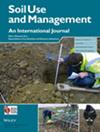利用田间尺度电磁感应数据检测放牧引起的土壤压实空间变化的农业地球物理建模框架
IF 3.7
3区 农林科学
Q1 SOIL SCIENCE
引用次数: 0
摘要
土壤板结被认为是一种主要的环境和经济危害,它使世界各地的土壤退化。众所周知,压实造成的土壤性质变化会导致生物量减少、温室气体排放增加、养分流失和土壤侵蚀。量化土壤板结的不利影响并制定改善策略,有赖于对土壤板结程度和时间变化的了解。土壤压实的主要指标(即孔隙空间减少、容重增加和土壤传输特性降低)在实验室条件下相对容易量化,但这种传统的基于点的方法几乎无法提供有关田间土壤压实程度的信息。最近,有人提出了地球物理方法来提供有关土壤压实的非侵入性信息。在这项工作中,我们开发了一个农业地球物理建模框架,利用电磁感应(EMI)数据帮助解决放牧围场土壤压实特征描述的难题。通过对放牧、土壤压实、土壤过程和 EMI 电阻率异常进行综合建模,我们展示了如何将 EMI 观测的空间模式与导致土壤压实和同时改变土壤功能的管理联系起来。该模型在爱尔兰中部地区的一个奶牛场进行了测试,该奶牛场几十年来一直在放牧,放牧引起的土壤板结特征明显。我们分别于 2021 年夏季和 2022 年秋季在干燥和潮湿的土壤湿度条件下采集了 EMI 数据。在这两年中,我们观察到表观电阻率下降的位置都有明显的压实特征,如植被减少和积水(如水槽和水门附近)。我们使用机器学习算法对 EMI 数据进行聚类,并假定三个独特的聚类特征分别代表重度、中度和非压实区。我们对非压实土壤和压实土壤进行了基于过程的一维模拟。模拟的电磁干扰特征在定性和定量上与测量的电磁干扰数据一致,将电阻率降低与明显压实的区域联系起来。通过提供一个基于土壤管理和压实机理建模的理论框架,我们的工作可为利用 EMI 数据检测压实引起的土壤退化提供一种策略。本文章由计算机程序翻译,如有差异,请以英文原文为准。
An agrogeophysical modelling framework for the detection of soil compaction spatial variability due to grazing using field‐scale electromagnetic induction data
Soil compaction is a regarded as a major environmental and economical hazard, degrading soils across the world. Changes in soil properties due to compaction are known to lead to decrease in biomass and increase in greenhouse gas emissions, nutrient leaching and soil erosion. Quantifying adverse impacts of soil compaction and developing strategies for amelioration relies on an understanding of soil compaction extent and temporal variability. The main indicators of soil compaction (i.e., reduction of pore space, increase in bulk density and decrease in soil transport properties) are relatively easy to quantify in laboratory conditions but such traditional point‐based methods offer little information on soil compaction extent at the field scale. Recently, geophysical methods have been proposed to provide non‐invasive information about soil compaction. In this work, we developed an agrogeophysical modelling framework to help address the challenges of characterizing soil compaction across grazing paddocks using electromagnetic induction (EMI) data. By integrative modelling of grazing, soil compaction, soil processes and EMI resistivity anomalies, we demonstrate how spatial patterns of EMI observations can be linked to management leading to soil compaction and concurrent modifications of soil functions. The model was tested in a dairy farm in the midlands of Ireland that has been grazed for decades and shows clear signatures of grazing‐induced compaction. EMI data were collected in the summer of 2021 and autumn of 2022 under dry and wet soil moisture conditions, respectively. For both years, we observed decreases of apparent electrical resistivity at locations that with visible signatures of compaction such as decreased vegetation and water ponding (e.g., near the water troughs and gates). A machine learning algorithm was used to cluster EMI data with three unique cluster signatures assumed to be representative of heavy, moderately, and non‐compacted field zones. We conducted 1D process‐based simulations corresponding to non‐compacted and compacted soils. The modelled EMI signatures agree qualitatively and quantitatively with the measured EMI data, linking decreased electrical resistivities to zones that were visibly compacted. By providing a theoretical framework based on mechanistic modelling of soil management and compaction, our work may provide a strategy for utilizing EMI data for detection of soil degradation due to compaction.
求助全文
通过发布文献求助,成功后即可免费获取论文全文。
去求助
来源期刊

Soil Use and Management
农林科学-土壤科学
CiteScore
7.70
自引率
13.20%
发文量
78
审稿时长
3 months
期刊介绍:
Soil Use and Management publishes in soil science, earth and environmental science, agricultural science, and engineering fields. The submitted papers should consider the underlying mechanisms governing the natural and anthropogenic processes which affect soil systems, and should inform policy makers and/or practitioners on the sustainable use and management of soil resources. Interdisciplinary studies, e.g. linking soil with climate change, biodiversity, global health, and the UN’s sustainable development goals, with strong novelty, wide implications, and unexpected outcomes are welcomed.
 求助内容:
求助内容: 应助结果提醒方式:
应助结果提醒方式:


